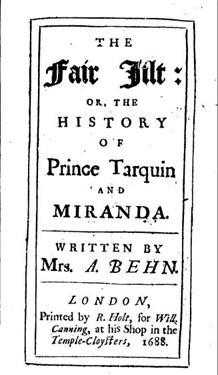The Fair Jilt
 Montague Summers notes in The Works of Aphra Behn that after the first edition, "History" in the title was changed to "Amours."[1] | |
| Author | Aphra Behn |
|---|---|
| Original title | The Fair Jilt: or, the History of Prince Tarquin and Miranda |
| Country | England |
| Language | English |
| Genre | prose tale |
Publication date | 1688 |
The Fair Jilt: or, the Amours of Prince Tarquin and Miranda is a short story by Aphra Behn published in 1688.
Background
The story is dedicated to "Henry Pain, Esq.," also known as Henry Neville Payne, a Roman Catholic agitator who was later arrested and tortured for his involvement in the Montgomery Plot of 1689.[1]
In The Fair Jilt, Behn claims that the story is true and that she witnessed much of it herself. Editor Montague Summers writes in his introduction to The Works of Aphra Behn (1915) that the story is only loosely based on actual events: "With all the nice skill of a born novelist she has so mingled fact and fancy, what did occur and what might have been, that any attempt to disentangle the twain would be idle indeed."[1] There was in fact a Prince Tarquino who was condemned to death by beheading in 1666 for the attempted murder of his sister-in-law. The London Gazette reported that the prince was only slightly wounded due to a mistake by the executioner, and was subsequently pardoned.[2]
Plot
When the story opens, young Miranda is living in a convent of Begines, an order of "galloping nuns" who take only temporary vows. Her parents are dead and her younger sister, Alcidiana, lives with an uncle. The seeming unattainability of the Begines makes them more desirable to men, and Miranda is beautiful, accomplished, and wealthy. Not surprisingly, she has many admirers; she receives their gifts and attention with pleasure, while loving none of them. Then one day she meets Henrick, a handsome young prince who has taken monastic vows and changed his name to Francisco. (Miranda's maid tells her about Henrick's tragic past in a story within a story.) Miranda becomes infatuated with Henrick. When he rejects her advances, she accuses him of rape and has him thrown in prison.[1]
Soon afterwards, Miranda meets Prince Tarquin and the two marry, but Miranda's extravagant lifestyle soon sees her wealth greatly reduced. She invites her sister to move in with her and Tarquin so that she can pilfer from her sister's funds. To keep a hold over her sister, she rebuffs all of her sister's suitors until Alcidiana moves out. Miranda then sends a servant to poison Alcidiana, which he does, but Alcidiana does not die and the servant reveals Miranda's plan to the authorities. The servant is hanged, and Miranda, due to her position, is only shamed, though a great sum of money is owed to Alcidiana and Tarquin is ordered to pay it by the court. Miranda talks Tarquin into killing her sister, and so he attempts to shoot her but fails. He is caught, confesses, and is sent to be beheaded, but the executioner misses the mark and hits Tarquin's shoulder instead, causing severe injury. Tarquin is then released, and he and Miranda leave the country. In the closing lines, it is noted that Miranda eventually repents her sinful past and that Tarquin has since died, though no explanation is offered for his death.[1]
Critical reception
According to Maureen Duffy, The Fair Jilt damaged Behn's reputation unjustly. Many readers found the story so hard to believe that they assumed it was fabricated, despite her insistence that it was true.[2]
Although a villainess, Behn's Miranda is not as repellent as the shockingly unhygienic Cornelia in The London Jilt. For this reason, Bonnie Blackwell credits The Fair Jilt, along with other works by female authors, with giving the word "jilt" a more positive connotation than it had in the past.[3]
References
- ↑ 1.0 1.1 1.2 1.3 1.4 Summers, Montague, editor (1915). "The Works of Aphra Behn, Volume V". Project Gutenberg. Retrieved 4 February 2015.
- ↑ 2.0 2.1 Duffy, Maureen (2013). The Passionate Shepherdess: The Life of Aphra Behn. Arcadia Books Limited. pp. viii. ISBN 9781909807938.
- ↑ Blackwell, Bonnie (2004). "How the jilt triumphed over the slut: the evolution of an epithet, 1660-1780". Women's Writing 11.
Further reading
- Flint, Christopher (1998). "From Family Romance to Domestic Scandal: 'Female Arts' in The Fair Jilt". Family Fictions: Narrative and Domestic Relations in Britain, 1688-1798. Stanford University Press. pp. 80–116. ISBN 9780804741880.
External links
| |||||||||||||||||||||||||
